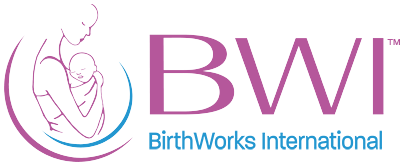Unique Science of BirthWorks
What we offer is evidence-based and academic theory informed. More and more research about primal health, skin-to-skin, zero separation and the deep significance of bonding and breastfeeding reveals we can trust – Birth is Instinctive!
Our evidence-based approach assures the best trained BirthWorks professionals, most well-prepared happy parents, and healthiest babies.
Find Ease in Labor and Birth!
The baby of a woman in optimal pelvic positions finds more space to move through the pelvic cavity, with its supporting muscles, of the pelvic diaphragm to descend into the pelvis for birth. We teach optimal nutrition that gives these muscles elasticity and tonicity to work more effectively at birth.
The cervix does not obey the laws of a sphincter as it is mostly connective tissue. The extracellular matrix of collagen fibers determine its strength. As it thins and softens for birth, the decrease in collagen concentration (rather than relaxation of the smooth muscle) and proteins increase tissues’ hydration breaking up the collagen fibers, to ripen for birth. This explains how important it is for a woman in labor to be well hydrated.
Birth is an engineering feat. Babies are already very competent at the moment of birth and in the passage through the pelvis always find the most available space to turn to be born. It is up to the mother to move into positions to give that space. This learning builds confidence and often shortens labor.
Small movements of the sacrum and ilium bone of the pelvis changes both the dimensions of the pelvic openings and the shape of the cavity. These movements have little importance in our daily lives but are of great importance during labor and birth. In counter-nutation, the base of the sacrum moves backward and the coccyx (tailbone) moves forward. This allows the diameter of the superior opening of the pelvis to enlarge. In nutation, the sacrum moves forward and the coccyx moves backward. This helps the inferior opening of the pelvis to expand. Therefore, movement of the sacrum is essential in labor to make more space for the baby to move through the pelvis. Women lying on their backs usually with epidurals in place, lose this advantage. The greater advantage comes with being in a variety of upright positions.
Soothing, positive words help a woman in labor to relax, but a much more powerful and effective way is to understand the connection between our hands and our breathing. Simply keeping hands relaxed during labor is a way to help contractions be more effective.
Understanding a negative feedback loop of chronic stress and ways in which it can harm both the pregnant mother and baby, helps us to see how essential it is to encourage positive thoughts so that the body can produce hormones of joy and improve our health. This is especially relevant in terms of labor preparation and during birth.
The thinking brain, when stimulated, is a “brake” to labor. We offer ways to quiet the neocortex to help a laboring woman access her primal brain to help her labor progress.
We speak our hormones.Understanding the paradoxical nature of hormones in labor, helps a woman and her birth team know ways to support her. These hormones have behavioral characteristics that are part of our ancestry to create the mother-baby bond at birth. “Is this a safe place?” is the question to ask the mother, so she can secrete hormones that help labor progress.
The uterus is the most amazing muscle in a woman’s body – growing through pregnancy and after birth knowing to return to original (fist) size. It knows how to contract down to birth the baby (and to help mother heal quickly after birth). This appreciation gives a woman a sense of wonder at the power she has in her body. This is the gift of birth.
Due to the physics of action, reaction, and resound, affirmations with positive thought patterns always work. If a woman carries negative associations or beliefs about birth, her birth may be more difficult. Positive affirmations can change the focus resulting in a more joyful and empowering birth experience.
Benefits for the Baby!
Primal Health (from concpetion to the first year of life) frames best-care practices during a critical time. It sees mother/baby skin-to-skin contact as a fetal agenda crucial for survival. Babies’ experiences in the primal period impacts adult health. We teach a deep appreciation for ways to improve this early physical and emotional health, which empowers and enhances lives.
Skin-to-skin contact literally saves babies lives. The mother-baby dyad, zero separation and honoring the innate fetal agenda are all possible, with the right information and support.
Optimal microbiome health helps to ensure a strong immune system in the baby. Babies receive most of this “seeding” of their microbiome during vaginal birth and have a decreased incidence of conditions such as asthma. Breastfeeding also makes a huge difference (and helps repair if cesarean was needed).
Understanding the power of breastfeeding is key. Breastmilk changes given the baby’s needs, gives immunity, and life-long benefits for health, wellness, and beyond—to help them thrive mentally, emotionally, and socially. Even if breastfeeding is not possible, using banked milk or optimal feeding skin-to-skin with infant formula assures best choices to support and love a baby.
Cells that fire together, wire together. Breastfeeding is more than nutrition—it forms the earliest pathways in the limbic or emotional brain, with the longest-lasting impact on a baby through adulthood. We offer preparation for easeful success.
Telomeres are part of DNA that shorten with each cell division and determine how fast our cells age, wear down, and die. Babies who breastfeed only (no formula or solid foods) in the first six months or more of life, have longer telomeres, which slows aging later and have a generational effect. Giving solid food before six weeks of age is linked to shorter telomeres, and it can cause inflammation and oxidative stress in infants’ guts. This is another reason exclusive breastfeeding is the best nutrition for young babies.
PRIMAL HEALTH RESEARCH

PRIMAL HEALTH RESEARCH
Dr. Michel Odent is on the BirthWorks Board of Advisors. He is a French surgeon and childbirth specialist who compiled decades of epidemiological studies on correlations between the “Primal Period” and lifetime health. BirthWorks proudly works with him to share this essential science!
The experiences of a baby during the primal period—from conception to the first birthday—impact health into adulthood, spanning a wide variety of medical disciplines. Special care must be taken to ensure good experiences for babies in this sensitive, crucial time.
The primal period is defined as the time from conception to the first birthday. It includes fetal life, the perinatal period and year following birth, so basically the time from conception to one year old. From Dr. Michel Odent: “The period of human development when the basic adaptive systems – those involved in what we commonly call health – reach their maturity was called ‘primal period‘: it includes fetal life, the perinatal period, and the year following birth. I also underlined the need for a simple term in order to get rid of the artificial and obsolete separations between the nervous system, the immune system and the endocrine system. I suggested the term ‘primal adaptive system’ when referring to this network: a way to avoid awkward terms such as ‘psycho-neuro-immuno-endocrinologic system’. Health is how well our primal adaptive system works. ‘Primal health’ is the basic state of health in which we are at the end of the primal period; after that we can take advantage and cultivate this basic state of health.”
Although some diseases are purely genetic diseases, epi-genetics shows that both genetic and environmental factors are at the origin of most pathological conditions and personality traits. Gene expression is to a great extent dependent on environmental factors during the primal period. So questions about timing come before those about genetic or environmental factors.
Some examples include how caesarean birth appears as a risk factor for obesity in childhood, and the gut flora of obese people is different from the gut flora of lean people, and the way the human gut flora is established in the perinatal period cannot be the same after a birth via the bacteriologically rich perineal zone compared with a birth by caesarean. It is also probable that studies here inspire interpretations based on explorations of the expression of Mitochondrial Uncoupling Protein2 (UCP2) in hippocampal neurons, which confirm the positive effects of stress in the perinatal period on brain development, such as correlations between different types of birth (forceps delivery, vaginal route after breech presentation or caesarean and comparative IQ. The database also explores the impact of oxytocin (and relation to type of birth and its impact on autism and eating disorders. These are just some examples of the depth and significance of the research.
This database is the unique tool providing some clues about this critical developmental period. It contributes to unprecedented classification of health conditions according to their critical period for genes-environment interaction, as many correlations established by epidemiologists can inspire plausible new interpretations.
His latest website https://www.wombecology.com grew from his research on Primal Health. Also, stay tuned as he might again join a BirthWorks event or conference.
“Primal health research is this framework of studies exploring correlations between what happens during the primal period (fetal life, perinatal period and year following birth) and its impact on health and personality traits in later life. The book Primal Health (published in 1986) predicted a new generation of research confirming that our health is shaped during the primal period, and soon after Dr. Odent opened a research center in London. Later, he was asked to write an updated version of the book, but with the constant evolution in research, he felt it most effective to compile and share research which he started doing quarterly in 1993. Since 1998, this database allows us to observe the development of primal health research (now a recognized term in the literature) and draw further, significant conclusions.
Read more about the value of the database, its history and evolution. Learn about over 1,000 primal health topics including “The Fetal Ejection Reflex,” “Obesity,” “Stress Deprivation” and “Cesarean” – just do a search by topic.
NURTURE SCIENCE AND IMPROVED NEONATAL OUTCOMES
Dr. Nils Bergman and Jill Bergman are relentlessly committed to understanding the impact of the mother-baby connection for optimal neurodevelopment. Their decades-long and recent research proves skin-to-skin contact literally saves babies’ lives!
BirthWorks offers education to learn–NurtureScience, Neuroscience, Kangaroo Mother Care(KMC)–through Kangaroula Training, Mentoring, and Certification!

NURTURE SCIENCE AND IMPROVED NEONATAL OUTCOMES

We have known that mother (or surrogate)/baby skin-to-skin contact after birth reduces mortality in infants with a birth weight less than 2.0 kg (4.4 lbs) by 40% once they are clinically stable, which averages three to seven days, but this new important study proves much more: “Among infants with a birth weight between 1.0 (2 lbs) and 1.799 kg, (3.96 lbs) those (infants) who received immediate kangaroo mother care had a lower mortality at 28 days than those who received conventional care with kangaroo mother care initiated after stabilization.”
The science now shows that the goal of Zero Separation from the moment of birth has been validated, with a further 25% reduction in infant mortality, helping premature and low birthweight babies to survive and thrive and potentially saving 150,000 lives each year according to the World Health Organization. This important study calls for a global paradigm shift in infant care including the development of “Mother Newborn Care Intensive Care Units” to create as close as possible, zero separation environments. The results of this study, funded by the Bill and Melinda Gates Foundation in a grant to the World Health Organization, were so significant that the trial was stopped early [no need to do further research as planned to prove the hypothesis] on the recommendation of the data and safety monitoring board owing to the finding of reduced mortality among infants receiving immediate kangaroo mother care.
- Long-term academic evidence for practical applications can optimize best standard newborn care for optimal health outcomes
- Understanding the mother-baby connection is most significant to health and development, so we must prioritize doing all we can to keep the mother-baby dyad together
- Zero-Separation of mother-baby is our biology and that the baby should never be left alone
- There is an Innate Fetal Agenda – the mother precisely controls every element of how her infant’s development unfolds – including physiology, heart rate, hormones, appetite, temperature and intensity of activity
- Brain wiring is place dependent – the critical moment of birth is when cells that are wired are fired
- There is a key role a Kangaroula can play in whether a baby experiences “nurture” or “protest and despair” at birth
- What we do can help avoid Infant Brain Dysregulation and enhance social connection through life (to avoid the tendency for later social withdrawal)
- Best ways to support both full-term newborns (born over 37 weeks) and premature babies (born at <37 weeks) which is around 1-in-10 births and these babies often have severe health issues and extended hospital stays
- Read these blogs: How is Kangaroula Support Valuable? Why should I get a Kangaroula? or What is a Kangaroula? How does a Kangaroula Support?
- Visit their websites: https://ninobirth.org or http://www.kangaroula.com
- Link to original published article, Immediate Skin-to-Skin Contact After Birth Improves Survival of Pre-term Babies, New England Journal of Medicine, 27 May 2021
- Press release (with concise summary) of the research findings: https://www.eurekalert.org/news-releases/482580
- PDF version of original article (to download or print easily): https://www.nejm.org/doi/pdf/10.1056/NEJMoa2026486?articleTools=true
Learn more here: Kangaroula Training Workshops & Certification
There is a lack of support for new parents and babies between birth doula and postpartum care, as well as a huge gap in typical medical practices, where babies (especially if premature or in intensive care) are routinely separated from their parents. Research shows this is detrimental to babies’ initial, very important (and ongoing) health, in particular neurodevelopment – of their brains and nervous systems! Plus, it saves lives!
Zero separation of mother and baby, especially in the first seconds, minutes and hours of life is critical – even in premature babies – because it equates to less stress and optimal development. What happens in the first few days impacts long-term well-being, breastfeeding success and even the baby’s ability to connect socially (long-term social emotional learning).
Kangaroulas offer intentional care helping parents be informed before labor, experience ideal support during birth, and optimize best practices once babies are born. Kangaroulas “educate” by modeling through actions ways that enhance health, create ease and support by honoring the mom-baby connection, and shift practices which (maybe well-intentioned) are often detrimental. Also, earning your Kangaroula credential is wonderful, to offer enhanced services to your clients (and make more money) by helping their babies – not just survive but thrive!
Learn more here: Kangaroula Training Workshops & Certification
A Kangaroula speaks for the baby’s needs, minimizes stress for a more peaceful transition, and empowers a mother to read the baby’s signals. How the baby’s brain is wired matters for coping, which is especially important for small or preterm babies. Conversely, a very stressful birth can mean a baby is epigenetically wired in a way that can lead to negative effects in adulthood. This can be minimized by zero-separation of mother and baby as the familiar SAFE PLACE and caring for them as ONE.
Kangaroulas make nurture science happen! Kangaroulas are the bridge between birth doula care and postpartum doula care. As well as understanding mothers’ needs, Kangaroulas advocate for the baby during birth as well as the first 1000 seconds, 1000 minutes & 1000 hours of life! Babies’ experiences are being wired into their brains then, so strongly impact development. Significant neurodevelopment and baby health depends on skin-to-skin and breastfeeding.
Learn more here: Kangaroula Training Workshops & Certification
There is a lack of support for new parents and babies between birth doula and postpartum care, as well as a huge gap in typical medical practices, where babies (especially if premature or in intensive care) are routinely separated from their parents. Research shows this is detrimental to babies’ initial, very important (and ongoing) health, in particular neurodevelopment – of their brains and nervous systems! Plus, it saves lives!
Zero separation of mother and baby, especially in the first seconds, minutes and hours of life is critical – even in premature babies – because it equates to less stress and optimal development. What happens in the first few days impacts long-term well-being, breastfeeding success and even the baby’s ability to connect socially (long-term social emotional learning).
Kangaroulas offer intentional care helping parents be informed before labor, experience ideal support during birth, and optimize best practices once babies are born. Kangaroulas “educate” by modeling through actions ways that enhance health, create ease and support by honoring the mom-baby connection, and shift practices which (maybe well-intentioned) are often detrimental. Also, earning your Kangaroula credential is wonderful, to offer enhanced services to your clients (and make more money) by helping their babies – not just survive but thrive!
Learn more here: Kangaroula Training Workshops & Certification
How we teach and what our childbirth educators and doulas offer
Effects of Love During Labor
Educare
Human Values
Experiential Interactive Learning
Entrainment
Holistic Approach to Birth
Testimonials







